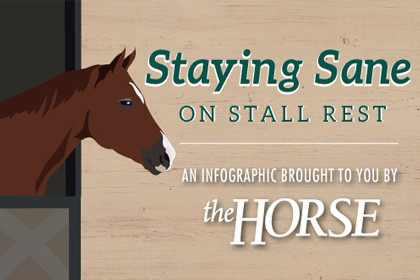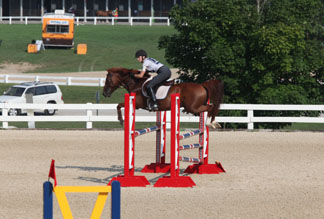
Goldilocks and the Twelve Riders
By: Kim Baierl
Goldilocks and the twelve riders sound like it could be an equestrian-themed fairytale. Well, if you have been fortunate enough to ride with or audit a Daniel Stewart clinic then some of your dreams may be coming true. Daniel has a way of creating enthusiasm and telling a story to provoke focus and learning and to inspire the desire to “make the rest of the ride the best of the ride”.

Harts Run Hunt and Rolling Rock Pony Club hosted the animated clinician at Double Springs Farm for a “Pressure Proofing” clinic over fences. Daniel began the clinic addressing all of the riders and auditors with his goals and expectations of the clinic. He explained how pressure affects our memory and we are good at panicking. His goal was to help the riders find the “Goldilocks” zone where things are just right but that requires us to leave our comfort zone to get there. Our comfort zone is a beautiful place but nothing grows there.
As Daniel started explaining how riders were to jump the 4 small Xs on a circle he also doled out information about accumulating faults and the associated points. I admit, in my mind I thought he was joking when he said that a chip or long-stride was 1 fault, crossing one’s path was 5 faults, a wrong lead over fences was 5 faults, etc. but figured there was some reason to his approach. Well, he was serious. For those of us who don’t jump and prefer a 20 x 60 sandbox, please keep reading as the overall message does apply to all riders.
Daniel was allowing each rider to learn by making mistakes and watching others all the while a scribe was keeping track of each rider’s accumulated points. Generously he considered it a successful clinic if the rider finished their session with 30 faults or less. I certainly don’t have the ability to deliver his message with the same gusto, but my take is that by assigning fault points he was increasing mental pressure on the riders to demonstrate the importance of being mentally focused and prepared for our sport.
Sports psychology, the study of mental factors as they relate to sports, is a niche in which Daniel has found much success. He has been an Olympic coach for the US Equestrian Team and the US Pentathlon team and a well-received author, so I decided he was an authority on the subject and I should heed his advice. He addressed a mental lapse in which I often fall. I’ve been pondering his view of being an athlete. I started thinking, “how often in my riding career has a non-equestrian commented that riding is not a sport”? Honestly, a fair amount to which I usually reply something about having a thousand pound teammate, weight-lifting with 40 pounds bags of grain, tossing hay bales rather than a kettle ball, etc. But truth be told, as an Adult Amateur I am constantly trying to find time between work, kids’ activities, volunteering, and housework to make it to the barn. My mouth defends riding as a sport yet I don’t consider myself an athlete. Not only does Daniel emphasize mental strength but also physical strength. Did I mention that there were sit-up involved in his clinic and that was just on day one? I’ve watched my daughter and another auditor practice the exercises presented on day 2 of the clinic with a smile as they get a short work-out in prior to grooming their horses.
I’ve seen Facebook posts touting strength-training or yoga geared towards riders. WPDA, recognizing the benefit of cross-training, has hosted some rider fitness clinics. In less chaotic seasons I find myself making it to the YMCA a couple days a week for a class or watching a YouTube yoga series at night to augment my riding. Unfortunately, those seasons are short and haven’t become an ingrained habit. Riders accumulating too many points found themselves seated on the mounting block doing canter-sit-ups. Picture yourself sitting on the top step of a mounting block with your upper body slightly reclined and your legs bent with your toes up and out like you are riding. The difference is that you bring your legs up to form one portion of the V and your body the other (for those who work-out it reminded me of the crunch-position I see when one is not doing a full sit-up). The position requires balance and core strength as you bring your legs into and away from your body (opening and closing the V) while your arms are bent and in front of you as if holding the reins. My challenge to myself is that each time I pass the mounting block by the entrance to the barn, I will stop and do canter sit-ups. If I can fit in sweeping the aisle and a few extra minutes hand-grazing my horse then I can create a new healthy habit with a few minutes of time.
Augmenting the fact that riding is a sport he had us laughing when he said that “riding is a lot like a sport, only harder”. He questioned if we had ever heard a skier yelling at her skis for spooking at a mogul or a tennis player fussing at his chestnut-mare racket for not cooperating.
I have pages of notes in regards to the exercises and the desired results. The gist was we are all good at making mistakes when we are rushing or panicked. He showed riders how they could slow down to evaluate a scenario and he discussed the difference between mental shifting and chunking. Essentially when one learns a new task they have to mentally shift between each portion of the task until it is repeated enough that the brain chunks it all together. For example, when learning to tie shoes, a child has to think about making a loop with the right lace, making a loop with the left lace, crossing the loops, bringing one loop up through the hole, and pulling tight. After enough repetitions the brain chunks those series of movements together into tying shoes and the child no longer has to think about the individual parts. In the jumping portion a rider needs to focus on picking up the correct lead, having the right approach, counting down strides in an authoritative voice, jumping, and checking the lead upon landing. By shifting from each of these steps to the next repetitively it eventually becomes a habit. The rider no longer will have to think to check for a lead, it will become automatic. While learning these skills he reassured riders that they can make mistakes and still be successful and was great at praising riders for accomplishments.
During the exit briefing I had a chance to talk with him about how he organizes a dressage clinic. His answer intrigued me as it involved dressage movements and a stop-watch. Harts Run Hunt Pony Club is planning on bringing Daniel back to the area in 2020 for sessions over-fences and for dressage and my name will be on the sign-up sheet for the dressage portion.
The amount of information he provided during the exit briefing is enough to fill a few more pages. I don’t want to spoil the clinic for you so you’ll have to register to ride or audit his clinic. I’ll leave you with a few memorable quotes from Daniel.
“Never a wrong time to do the right thing”
“What you want in your horse you have to create in yourself”
“Set-backs create come-backs”
“Adversity creates strengths and resilience so struggle well”
“The older we get the more we tend to evaluate ourselves by our mistakes”
“Define yourself by effort made and not the outcome”
“When you can’t do everything, do everything you can”.
“Always be happy in your happy place.”





